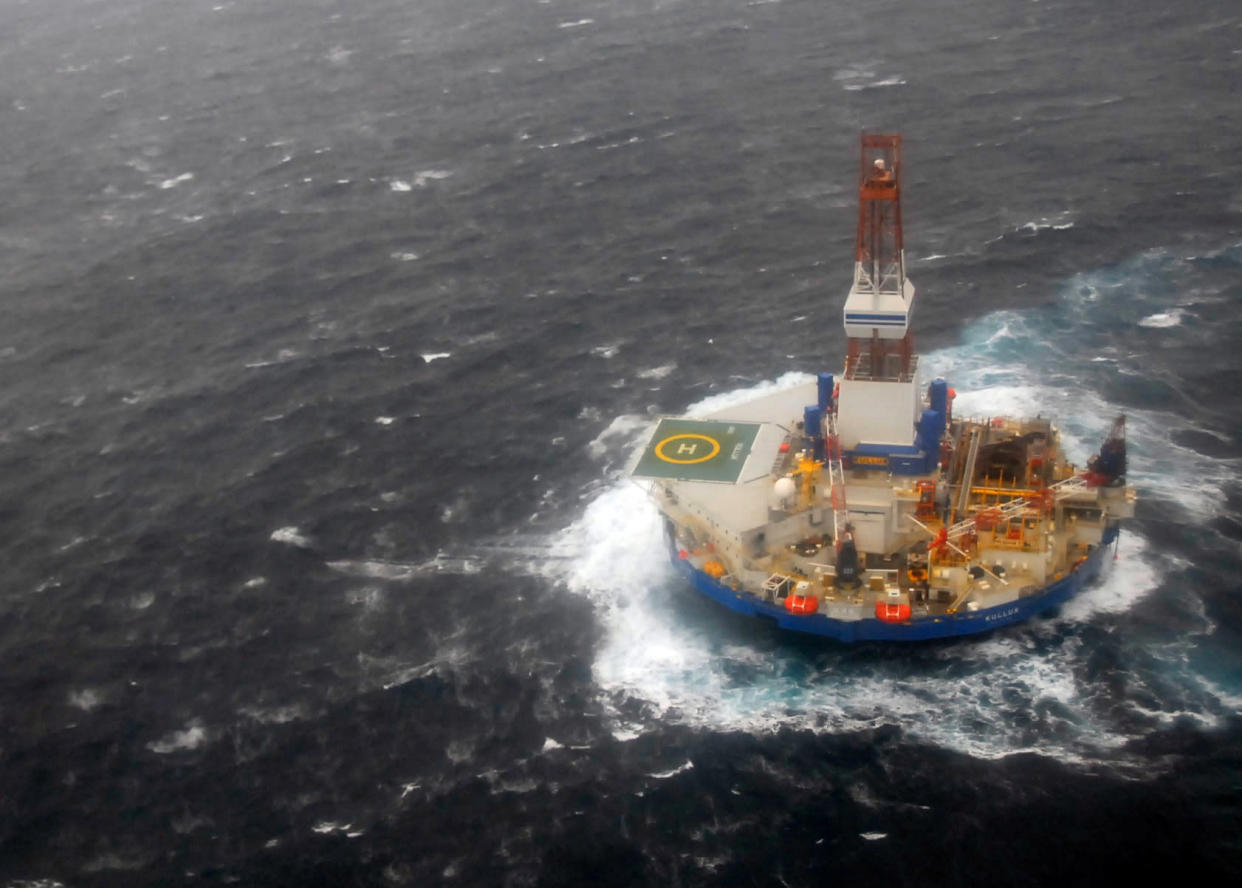No sheen seen, but drill ship status uncertain
No oil sheen seen near Shell drill ship aground on island off Alaska but status uncertain

In this photo provided by the U.S. Coast Guard, the mobile drilling unit Kulluk is towed by the tugs Aiviq and Nanuq in 29 mph winds and 20-foot seas 116 miles southwest of Kodiak City, Alaska, Sunday, Dec. 30, 2012. The crews remain stationed with the drill rig Kulluk Sunday 20 miles from Alaska's Kodiak Island as they wait in rough seas for another tug boat to arrive. The Coast Guard says the goal is to tow the Kulluk to a safe harbor and determine the next step. (AP Photo/U.S Coast Guard, Chris Usher)
ANCHORAGE, Alaska (AP) -- The Coast Guard was trying to determine Tuesday whether a strong Alaska storm had abated enough to allow for a helicopter to assess the condition of a drilling rig that ran aground in shallow water off a small island.
If conditions are safe, the helicopter would also lower experts to the Kulluk to get a close look at the rig and determine if it is leaking fuel, said Curtis Smith, a Royal Dutch Shell PLC employee speaking for a unified command center set up in an Anchorage hotel.
About 250 people from the Coast Guard, Shell, state responders and others were involved in a response effort and waiting to know for sure what environmental impact the grounding might have caused.
Storm conditions remained severe Tuesday morning with the grounded rig likely taking a pounding. Winds were reported at up to 70 mph, with waves 35 feet and 45-foot swells. Some waves overnight reached 50 feet, the National Weather Service said.
The forecast called for both wind and waves easing Tuesday afternoon.
"We are doing whatever we can do to prepare," said unified command center spokeswoman Destin Singleton said.
The Kulluk is carrying 150,000 gallons of diesel and about 12,000 gallons of lube oil and hydraulic fluid. "The condition of the Kulluk has not been confirmed," unified command said in a status report issued about 12 hours after the grounding.
The drilling rig was built with a double-sided hull of reinforced steel that is 3 inches thick, Smith said.
The drilling rig's difficulties go back to Thursday when it separated from a towing vessel south of Kodiak Island as it was being towed to Seattle for maintenance. The rig grounded Monday night on a sand and gravel shore off the southeast side of Sitkalidak Island, an uninhabited island in the Gulf of Alaska.
The North Pacific storm that has caused problems for Shell's efforts to move the drill into place near Kodiak Island was expected to ease a bit Tuesday, said spokeswoman Darci Sinclair.
U.S. Rep. Ed Markey, D-Mass., who is the top Democrat on the Natural Resources Committee, issued a statement Tuesday expressing his concerns about the Kulluk situation.
"Oil companies keep saying they can conquer the Arctic, but the Arctic keeps disagreeing with the oil companies," Markey said. "Drilling expansion could prove disastrous for this sensitive environment."
The Kulluk was being towed Monday by a 360-foot anchor handler, the Aiviq, and a tugboat, the Alert. The vessels were moving north along Kodiak Island, trying to escape the worst of the storm. Sitkalidak is on the southeast side of Kodiak Island.
About 4:15 p.m., the drill ship separated from the Aiviq about 10 to 15 miles off shore and grounding was inevitable, Coast Guard Cmdr. Shane Montoya, the acting federal on-scene coordinator, told reporters.
"Once the Aiviq lost its tow, we knew the Alert could not manage the Kulluk on its own as far as towing, and that's when we started planning for the grounding," he said.
The nine-member tug crew guided the drill ship to a place where it would cause the least environmental damage. The tug cut the unmanned ship loose at 8:15 p.m. and it grounded at 9 p.m.
Susan Childs, Shell's on-scene coordinator, said it was too early to know how the vessel would react to the pounding of the storm when it was aground and stationary. She was optimistic about its salvage prospects and chances for staying intact.
"The unique design of the Kulluk means the diesel fuel tanks are isolated in the center of the vessel and encased in very heavy steel," she said.
The drill ship worked during the short 2012 open water season in the Beaufort Sea off Alaska's north coast.
____
Associated Press staff writers Dan Joling in Anchorage and Donna Blankinship in Seattle contributed to this story.

